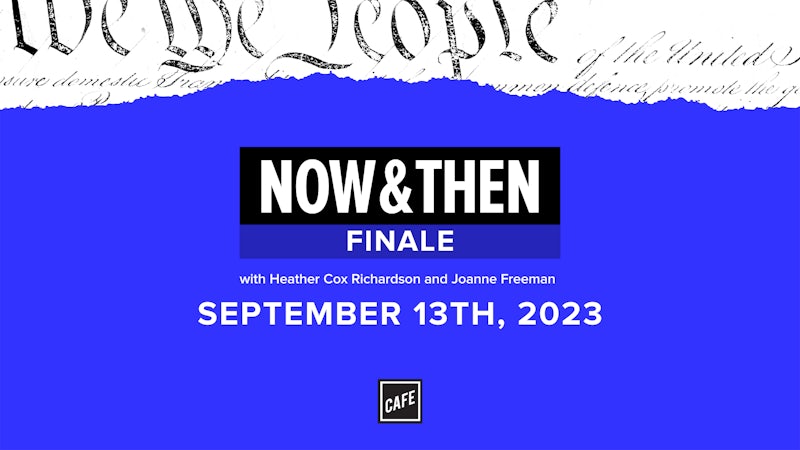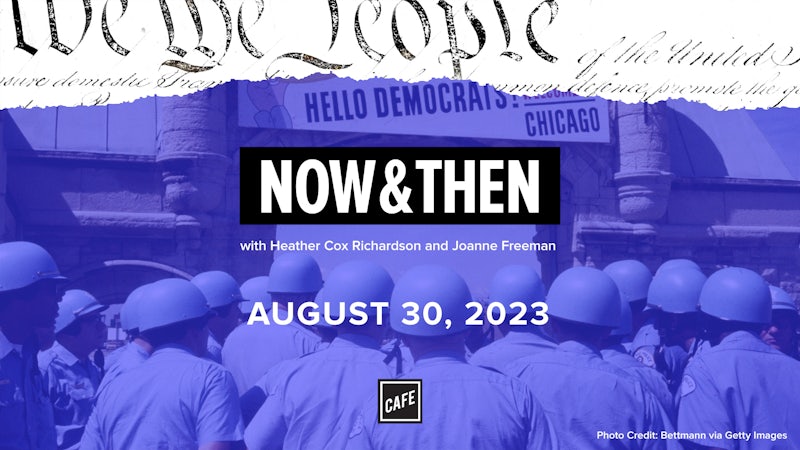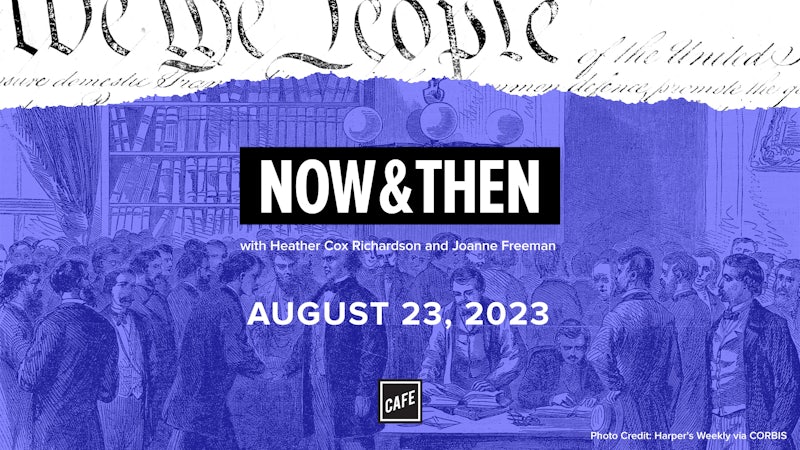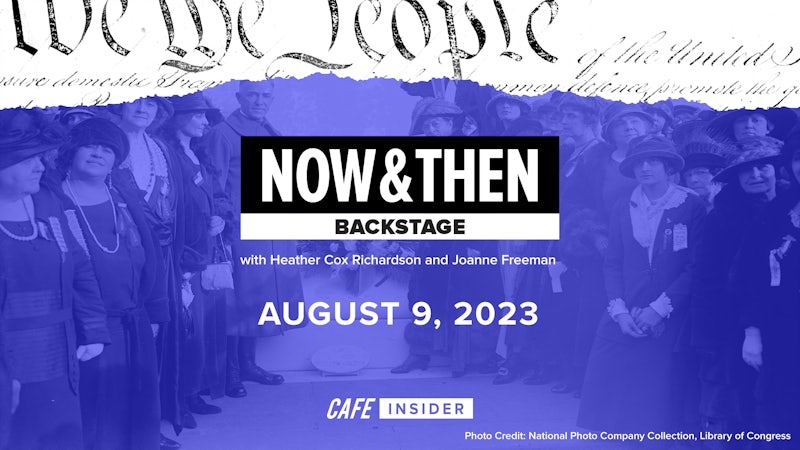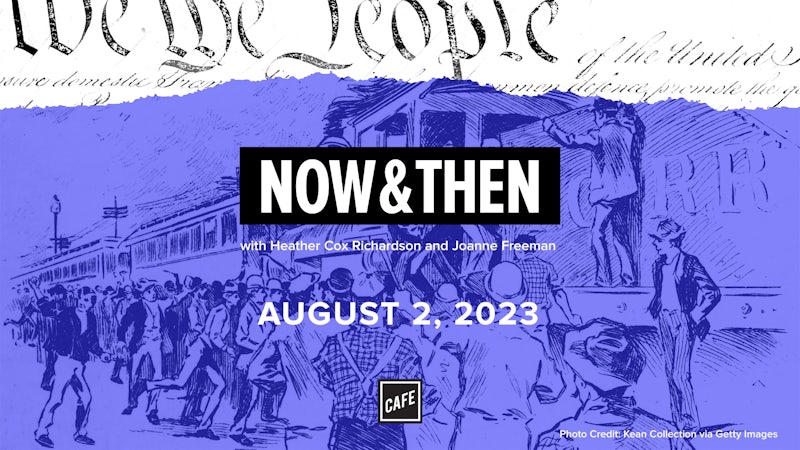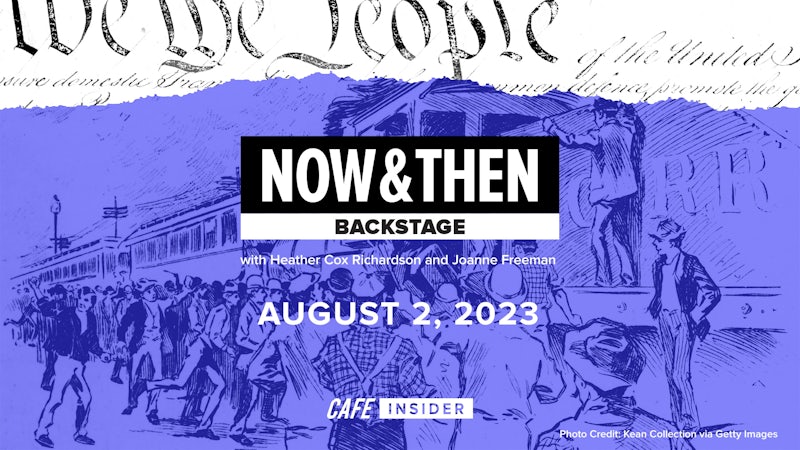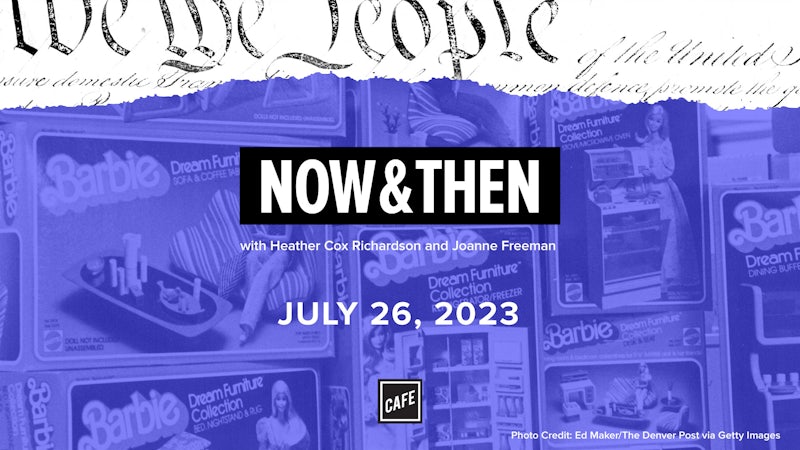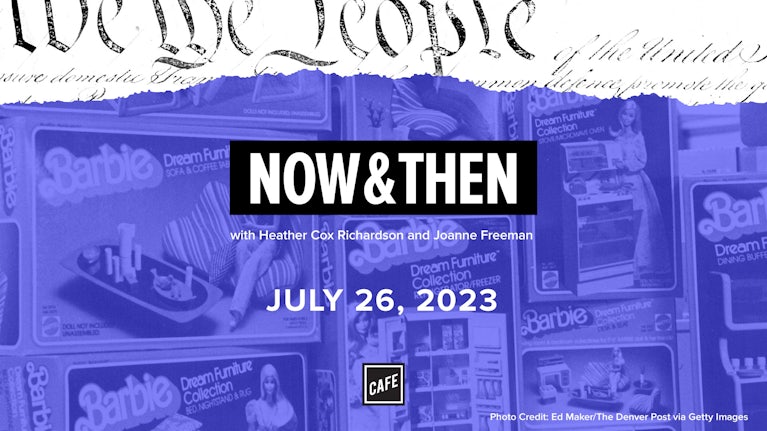Heather Cox Richardson:
From Cafe and the Vox Media Podcast Network, this is Now & Then. I’m Heather Cox Richardson.
Joanne Freeman:
And I’m Joanne Freeman. This week we’re going to talk about a topic that might seem related to, but not precisely the topic we should be talking about. You would think that we would be addressing the air and smoke and fire because of the ways in which particularly us on the East Coast, in the Northeast were bombarded with the weirdness of the air and it filled the press and everyone was talking about it. But what we want to talk about today is related, and I think as you’ll see, really encompasses a lot about where we are as a nation and where we’ve been. And that is the question of water.
Now, off the cuff, I think that sounds very basic today, Heather and I will talk about water, but that’s precisely why it’s important, because it’s so basic that it underlies everything. This is the most obvious thing to say, but it relates to any nation and urban growth and national growth. It’s essential for life. And as we’ll see in what we’re talking about, there are any number of different ways in which major portions of the United States had their fates shaped sometimes in a dramatic way by the politics and economics and natural phenomenon and weird personality quirks and everything else that just went into the question of water, where we get it from and who gets it.
Heather Cox Richardson:
And of course, the larger question about water is the question of natural resources. Who gets to have control over natural resources? Who gets to have natural resources and how people jockey to make sure that people have enough air and water, for example. And that’s been in the news hugely lately because of the ongoing drought around the Colorado River now for years and years. And the extraordinarily low water table out there because of that drought that has forced a number of states to come up with a new agreement for use of water in the Colorado. On May 22nd, LA just last month, the Biden administration announced an agreement of three western states, California, Nevada, and Arizona, although it encompasses other states as well, to reduce the water that they’re taking from the Colorado. And that was a really big deal because no matter how hard they tried, they couldn’t seem to get all three of the big states on board, but especially California to come up with their own system for how to divvy up the water in the Colorado.
And the way they finally did it was that the Biden administration put a lot of pressure on them, basically said, “If you don’t come up with a plan, we will and you will all lose.” And what they agreed to finally was that in exchange for limiting the use of the river’s water by 13%, the administration will pay the irrigation districts, cities and Native American tribes in those states, a collective $1.2 billion, which is designed to enable them to find ways to conserve water and to find alternative ways and more efficient ways to run homes, to run farms and so on.
Joanne Freeman:
And it’s worth noting here, just talking about numbers that about 40 million people drink water sourced from the Colorado River. So we’re talking about a big body of land, we’re talking about a big body of people. And at present, the Colorado River is at only about two thirds of its typical water levels. So there’s very logical fear of a water shortage that could do damage to big cities like Los Angeles and Phoenix.
Heather Cox Richardson:
That’s not the only reason that water has been in the news. In a development that was connected to this. The governor of Arizona, Katie Hobbs, who Democrat said on June 1st that she was announcing a pause on certain types of development around Phoenix because of the Colorado River’s low levels and because of the fear of groundwater shortages throughout the state. And one of the things that’s happened during the drought years in the American West is that as public water has failed, people have been digging wells to tap into the groundwater, which of course is making everything worse. So Maricopa, which includes Phoenix, has used water extensively, and much of it has gone into the real estate and commercial development sector, which has been expanding very rapidly. So the county uses 2.2 billion gallons of water a year, and that’s twice as much as New York City, although it has half of New York City’s population.
So what Hobbs has done is to restrict the construction of new developments that rely exclusively on groundwater. So developers are expected to line up for water from other sources, including indigenous tribes and farmers who could sell their water rights.
Joanne Freeman:
That means that there’s going to be a rush for water access, which will likely lead to a spike in home and office prices, which will probably pause the massive numbers of people who have been moving into the Phoenix area. So it’s like a chain reaction, a perfectly logical one. But this will dramatically affect not just the lives of the people in this area, but really the nature of the city itself in pretty dramatic ways.
Heather Cox Richardson:
Of course, there’s been a huge pushback from developers and so on saying, how dare you do this to me? And it’s like, this is not random here. There’s a resource that there isn’t enough of. And what you are saying is, in our short amount of time developing, because of course they’re not there for the long term, you should be able to use that resource and then get the hell out so that everybody else has to deal with the mass. And that right there is I think an important theme for our use of water, but also our use of resources in the United States.
Joanne Freeman:
Particularly in the West, where the cities grew very rapidly in part because of things like water access, unlike the East Coast where there’s a much longer history for these cities going back to colonial times, so that that’s actually you’re right. Part of it too is these boom growths and building in which people rush in and supply the demand and then don’t necessarily stick around.
Heather Cox Richardson:
Water is important enough in the Euro-American settlement of this continent that our major settlements like Boston are literally around springs. They literally need to have water to drink and good water to drink. And they literally, in the case of Boston, decide to settle in Boston on, sorry, somebody else’s land. Not just indigenous Americans, but they literally buy land from a settler who was already here.
Joanne Freeman:
Jamestown, Virginia, when it first is established as a settlement, it fails in part because the water supply is dismal, it’s salty, it’s not supplying life to these people. So there’s a settlement in which the lack of a water supply really helps to do it in.
Heather Cox Richardson:
But there is a question in the early colonial times, should you have free water? Should there be public water? Or should people be able to monopolize that resource and sell it? What does the community provide and should the community provide is central, as I say, to the development of these colonial systems, because of the fact water is rare, good water is rare and it’s valuable, and should people be able to sell it if they’re the lucky ones who get there first? Or is there a public interest in making sure that people can actually have something to drink? Where do you draw the line where people should actually have a right to it like we assume now in the United States, they should have a right to water? Which is again, a really interesting question right now with the many places in which municipal water has not been clean.
The idea that when you have a common resource, and I’m going to use this term in air quotes here, people tend to try to monopolize that resource rather than sharing it fairly. And I think that that’s one of the central questions of this water issue, but also of the 21st century, what does it mean to have a common resource that is finite and that is endangered as in the climate? And what do we do about those individuals? We’ll start there, who want to monopolize it to the fact that it is killing us?
Joanne Freeman:
Now, this, not surprisingly, as we suggested in starting out with Boston and Jamestown, the issue goes all the way back. And the example that we’re going to talk about right now is a stellar example of the ways in which water and its control is hyper political and bound up with capitalism to a major degree. Now, New York, again, at a very early point, a relatively major development, and then in time, very major area of development in the new world. And then the United States from the 17th century, the early 17th century, they had problems with cholera and yellow fever. There was an assumption there wasn’t a necessarily a direct link, but there was an assumption that the yellow fever was linked to the water supply, which indeed it could have been since yellow fever being mosquito borne and bad drainage leading to places where mosquitoes would be very happy with each other, making more mosquitoes that there could be-
Heather Cox Richardson:
Is that the scientific version, Joanne?
Joanne Freeman:
I just realized in the middle of saying it, I was like, and now I’m talking about mosquito sex. How did that happen? How did I find that window to climb into? Anyway, at any rate, there was a connection in New York between water and health.
Heather Cox Richardson:
And let’s just throw in here that these diseases, these waterborne diseases, they didn’t really know what most of them were, but they are particularly horrible. Waterborne illnesses are gastrointestinal, but cholera, yellow fever, they are, I mean, I’m not going to be totally graphic here, but you are going to die in really, really hideous ways.
Joanne Freeman:
And thus, not only are these horrible diseases, but when you get a wave of one of them, people flee the city, there’s mass evacuation, and then that becomes an issue because you have people from a disease ridden city, hopefully trying to get into another city, it actually causes a lot of unrest. Now, early on, the water system in New York was kind of piecemeal, and the fact of the matter is that aspects of it were expected to be tended to by private citizens just because the water ran through where these people were.
So for example, in 1743, a local politician Cadwallader Colden wrote an essay about the problem saying that a corporation should be formed to clean the drains and improve the water system. And as he explained it, I am of opinion this water purification cannot be done effectually, but by the drains being put entirely into the hands of the corporation for as they are now in the hands of private persons managed only by voluntary subscription and dependent on the humors and inclinations of a great number of persons, many of them penurious, negligent and insensible of the prejudices which follow on the drains not being kept in good order.
Heather Cox Richardson:
Well, and he’s calling for a corporation to do it, which in this period did not mean what we understand a corporation to be, but rather a state chartered organization with public interest. So he is saying basically, they don’t really have a concept of the state itself doing it, but the idea that the state should step in and make sure that the colony has safe water and drainage.
Joanne Freeman:
Now, in the mid 18th century, wealthier New Yorkers would ship water in from a what at the time was known as the collect pond, which was just north of New York City actually now modern day Chinatown, they would ship in clean water. In 1798, there was a yet one of many brutal yellow fever outbreaks. And again, logically enough, given the haphazard way in which water’s being handled in New York, there was a big cry for dealing with the water supply. So Noah Webster, dictionary Webster, his newspaper, the Commercial Advertiser, was particularly blunt on this. He said, “The New Yorkers are like the rich man told of in the parable, they have no clean cool water to slack their thirst. When the flames of the plague are devouring their vitals, they pretend their city water is very pure and nice. It is no such thing.” And now we get the arrival of Aaron Burr because somehow or other, what if there’s a big issue in this time period? I always feel like Burr is coming around the edges, and in this, he’s kind of a smack in the center of it.
Heather Cox Richardson:
But it’s fitting he is because he’s always sort of in the center of the relationship between people and power and people and resources. And so he’s a wonderful person to be here. Should I like Aaron Burr, by the way. I sort of feel like he’s, sorry, kind of a weenie.
Joanne Freeman:
He gets kind of a bum wrap, but he’s problematic.
Heather Cox Richardson:
And there encapsulates the difference between us. I call him a weenie, you say he’s problematic. Okay.
Joanne Freeman:
Well, yeah. He’s not the villain of early America, but he’s opportunistic.
Heather Cox Richardson:
I have to assume his opportunism shows up in the whole water thing.
Joanne Freeman:
Big time. Big time. So at this point, we’re talking the end of the 18th century, he had been a US senator from New York. Now he’s a member of the New York Assembly, and he’s someone who’s well known and has some degree of power. His brother-in-law, Joseph Brown, was a leading Westchester doctor who really wanted to find some kind of pure water source away from Manhattan. So Burr and Brown probably come up with the idea of creating some kind of a water company, some kind of a utility that will allow them to find a way to bring in water. That’s the claim. But the fact of the matter is that Burr inserts a C clause into the charter of this utility, which makes it very clear that the company can raise money and apply that money to the water company, and leftover money can be used or invested in other ways.
Heather Cox Richardson:
It’s cover. They’re saying they’re going to fix everything, but they’re really doing is finding a way to get a charter for what is essentially a bank.
Joanne Freeman:
Precisely. They want a bank. They want a bank that is friendly to their politics because the major banking in New York at that time is associated with the Federalists and Hamilton so Burr, who by this point is a Jeffersonian Republican, he’s thinking, this is great, right? Yeah, we’re going to help the water supply, and I’ll insert this clause that says we can raise money and then we’ll apply some of it to fixing the water. And then he doesn’t say this out loud, we’ll use most of that money to create a bank and fund investments from the people who we like politically. So that is indeed what happens.
Heather Cox Richardson:
Okay. That’s not okay.
Joanne Freeman:
No, it’s not okay at all. He’s claiming he’s going to solve the water crisis and he doesn’t. You’re moving into weenie territory. That’s true.
Heather Cox Richardson:
Well, yes, yes. I didn’t say that. But it’s also a really interesting moment when somebody is taking what is a deeply problematic public health issue that people really want to fix and are saying, here’s a way to fix it, sweetie. And then I’ll just, I’ll take all the money and do what I want with it.
Joanne Freeman:
And then not only that, it gets people to invest in it. Some of them, assuming it’s a water company, including Alexander Hamilton, who you know is like, yeah, okay, this is great. We need to deal with the water supply. And there’s all kinds of things in Hamilton’s writings when he discovers instead, what Burr has really created is what Hamilton calls a monster bank. It shouldn’t exist. It’s a spurious kind of spur of the moment political bank, and thus in Hamilton’s eyes, evil and bad. So yeah, it’s a cover, and it’s a cover covering over a really important issue for New York. Now, the company ultimately raises near $2 million, which I have to say in 1798, 1799 is massive. They, I’ve seen different accounts of how much they used in the water supply. I did not see any accounts saying it was more than $100,000. So everything beyond that is funding this other plan.
Heather Cox Richardson:
I’m here in the 21st century, and I’m about this in the 21st century.
Joanne Freeman:
Yes.
Heather Cox Richardson:
Okay.
Joanne Freeman:
Yes. No, totally. So he and his cohort do try and do something with that however much, $100,000, and it doesn’t do a very good job. They actually use hollowed out tree trunks for pipes and they dig wells. I’ve actually seen… Well, New York Historical Society has one, and here’s an important fact. What starts out as the Manhattan Company ultimately becomes down the road, Chase Manhattan Bank. So I’ve actually been to the archives of Chase Manhattan Bank and seen they have a piece of the original pipe.
Heather Cox Richardson:
Wait, wait, Chase Manhattan Bank comes out of this?
Joanne Freeman:
Yes.
Heather Cox Richardson:
Wow.
Joanne Freeman:
Indeed. Which tells you precisely what we’re talking about here. It’s a guy and his friends who pretend to be really focused on the water, but they want to create a bank, and the bank part goes swimmingly…
Heather Cox Richardson:
So to speak.
Joanne Freeman:
… and eventually… Yeah, well, I didn’t actually mean that fun, but now I can claim it. But yeah, that over time ultimately becomes Chase Manhattan Bank.
Heather Cox Richardson:
And that’s fine because New York has no further problem with water and Hamilton and Burr makeup and are friends for the rest of their lives.
Joanne Freeman:
Yeah, yeah.
Heather Cox Richardson:
All right. So what happens? They say they’re going to raise all this money to fix the water supply. They don’t fix the water supply. I’m going to go on a limb here and suggest the what’s going to hit the fan. And a lot of people are going to die in another disease outbreak.
Joanne Freeman:
Correct. Yet another yellow fever problem in 1805, 1000 die. More than a third of the city’s population of 75,000 flee the city to escape from the disease. So they have to continue to wrestle with this until finally in the early 1830s, there’s a cholera outbreak, yet another horrible disease. Another third of the city’s population flees during this 1832 cholera outbreak, and many New Yorkers again focus on drinking water and sanitations. At this point, the city’s board of health suggests tapping the Croton River. And engineers come up with a design for a kind of an aqueduct that takes advantage of gravity to bring water to the city.
And in 1835, New Yorkers vote in favor of the plan. On July 4th, 1842, the first water arrives in New York. And when I was poking around, because I didn’t know a lot about this, I discovered just a little factoid and it made me ridiculously happy. So the first water, there’s been an ongoing water crisis for decades and decades and decades, and now there’s this new plan and it’s bringing fresh water. What do New Yorkers do to celebrate? Fountain displays. Like, woo-hoo, let’s throw the water around. This is great. I just love both the glee and the ridiculousness of that.
Heather Cox Richardson:
And yet it is such a huge thing that in novels in the 19th century when they’re talking about sort of the modern world and upscale housing, they say it has Croton water.
Joanne Freeman:
Exactly. And so here you have in the end, as we suggested at the outset, you have a government stepping in to help take control of this process, which it hadn’t been part of before. And you have the fate of a city bound up with it as well. You have politics, party politics of an extreme degree mixed in with this. It really, ultimately, fundamentally is about Federalists versus Republicans. All of this in what seems to be a sort of surface level story about a water company.
Heather Cox Richardson:
The idea here that they finally say, we can’t trust individuals to do this, and we’ve got to do this ourselves, is really important in the use of resources. And in this case, some New York dude named Aaron Burr seemed to think that this was a lovely way to, not necessarily to monopolize the resource, but to not monopolize the issue. And this was an issue that absolutely had to be addressed. So he’s not monopolizing water at this point, or rather he’s simply using it politically.
Joanne Freeman:
Because it is something that is essential, and in essence, although he’s not monopolizing it by using it, he’s monopolizing the opportunities surrounding it. So it’s not until 1842 that New York City has a clean water supply just pretty late in the game.
Heather Cox Richardson:
While the New York story is interesting, the city that is usually associated with water fights in the United States is Los Angeles. And Los Angeles starts on a small river, and it quickly outgrows that. So when it outgrows that we’re going to get the concern of the organizers of Los Angeles, people are trying to make that city grow, that they’ve got to find another water supply. What they decide is that having run out of enough water in the Los Angeles River, there’s another lovely river nearby called the Owens River and the Owens River, they hope they can simply turn into a similar system to the one they have in New York where they’re going to pump water from that river system into Los Angeles. There’s this one little teeny tiny problem with that, and that is that there are people who rely on the Owens River for their livelihoods.
Joanne Freeman:
And the dynamic of growing gobbling up water, which makes more people come and thus they need more water, that it’s an ongoing cycle, which is part of what we started out by talking about with Katie Hobbs in Arizona trying to stop it.
Heather Cox Richardson:
It really is astonishing. Here we are talking about the history of Los Angeles, and it’s like, oh, look, they’re sheep. And the truth is that we’re still dealing with those same decisions today. The story behind Los Angeles is that the Los Angeles after the Civil War is a growing city at that point, the water in it is supplied by the Los Angeles Water Company, which is a private supplier of drinking water. And the person who’s in charge of the water company is a man named Fred Eaton. Fred Eaton becomes friends with another man whose name will probably sound familiar, and that’s William Mulholland. Mulholland was a immigrant from Belfast, Ireland. He came to the United States in 1855, and he got to Los Angeles in 1877 when the population was about 9,000 people. So a growing city. During his first year, he served on a well drilling crew, and he became interested in civil engineering, which is a growing profession in the United States, especially in the north after the war.
And he becomes a ditch tender for the Los Angeles Water Company. So Eden and Mulholland got together. They both look at the growing city, and of course, their fortunes depend on that growing city, and they decide that they need new water for it. So Eden goes into city politics in 1886, and when he leaves his job as the superintendent of the water company, he puts Mulholland in his place. From 1898, they’re climbing their way up together, and then from 1898 to 1900, Eaton becomes Los Angeles’s mayor. And the population just booms. It goes up over 100,000 people.
Joanne Freeman:
But I want to point this out for a minute. In 1877, the city has a population of 9,000. In 1900, it’s 100,000, and four years later it’s 200,000. So we keep talking about people running into these cities. The rate of that is massive.
Heather Cox Richardson:
Yes. And think of everything that goes with that, the economic boom, the incredible money to be made very quickly in this booming economy. The extraordinary tensions, by the way, as people are struggling over control of land over the different populations that are getting moved around in these cities, labor issues, race issues, they’re also incredibly tense places and places where, I’m so sorry, Joanne, mushroom men can do extremely well.
Joanne Freeman:
I appreciate the fact that I have given that phrase to so many people. A mushroom man is an 18th century way of describing someone who sprouts up out of nowhere, doesn’t have any roots, and who the heck is this guy? And what do we know about this guy? A literal, shady character.
Heather Cox Richardson:
So Eden and Mulholland start talking about where they can find more water, and they decide, as I say, to turn to the Owens River, which comes down out of the Sierra Nevada mountains, about 250 miles east of Los Angeles. So in 1904, they begin to work on the Owens Valley plan. They travel up to the Owens Valley, which is very well watered, by the way, by the Owens River, and they decide to create a Croton Aqueduct style project that would use gravity to bring that river into Los Angeles. And Mulholland later said, nature is the squarest fighter there is, and I wanted this fight. When I saw it staring me in the face, I couldn’t back away from it.
Joanne Freeman:
Manly, manly, manly.
Heather Cox Richardson:
Yeah, Theodore Roosevelt, isn’t it? I mean, it’s not. It’s Mulholland, but it could be Theodore Roosevelt.
Joanne Freeman:
No, but it sounds exactly. Yeah.
Heather Cox Richardson:
So he starts to construct this aqueduct. He gets millions of dollars in municipal bonds to finance this extraordinary project. And when the project goes public, there’s some people who are not happy about it.
Joanne Freeman:
The people in Owens Valley.
Heather Cox Richardson:
That’s right.
Joanne Freeman:
I mean, they’re not happy. The local newspaper, The Register in 1905 has the headline, “Los Angeles Plots Destruction: Would take Owens River, lay lands waste, ruin people, homes and communities.” Of course, they’re not happy. LA is like, yeah, we’ll come and basically take that water. Thank you very much. We need it.
Heather Cox Richardson:
So the people in Owens Valley protest strongly against this, and Mulholland needs the approval of the federal government to get the aqueduct in place because it has to go across government lands. So he goes off to Washington in 1906 where he finds President Theodore Roosevelt, who is so into the diversion of water, that he at one point says that the Newlands Reclamation Act that would put irrigation all over the West is the most important thing he did in his presidency.
Joanne Freeman:
And if you think of someone who represents, admittedly preserving, but also mastering nature, he’s a happy camper at this particular moment with this particular issue because that is so much a part of his kind of ethos is this mastery and all that it means nationally and actually personally as well.
Heather Cox Richardson:
So he gets behind the project and with his support, Congress votes in favor of it. And Roosevelt says of it is a hundred or a thousand fold more important to state that this water is more valuable to the people of Los Angeles than to the Owens Valley, which I’m sure the people in the Owens Valley are like, Hey, hey, wait, hey, wait.
Joanne Freeman:
Wait.
Heather Cox Richardson:
But that’s the idea of using a resource in this case for economic growth, for the idea of this extraordinary growth in Los Angeles. So in Mulholland takes the next seven years to oversee the massive project in between the Owens Valley in Los Angeles, which is largely a desert. And in November 1913, the first water came over the aqueduct. And when it appeared in Los Angeles, Mulholland brandished an American flag, and he turned to the mayor of Los Angeles at the time, H.H rose, and he said, there it is. Take it.
Joanne Freeman:
I know I keep coming back to this theme. I write a lot about masculinity and politics and the quotes that we’re seeing and the swaggering that we’re seeing are so right smack in the middle of it. There it is. Take it. Okay, you have mastered it.
Heather Cox Richardson:
So Los Angeles’s population continues to go up thanks to the water. By 1924, it has 1.2 million residents that of course has already at that point overtaxed the Owens Valley River. So they’re going to start looking to the Colorado. It wreaks havoc for the residents of that area who are by now so furious at Mulholland that they form a vigilante group led by a group of brothers and local bank owners named Wilfred and Mark Waterson. And they begin to sabotage the aqueduct. They dynamite large sections of it. They seized pump houses and drainage ditches and Mulholland for his part, raged against them and tried to buy up their lands. But the Los Angeles residents increasingly sympathized with the underdogs. So the Los Angeles Times, which had been backing Mulholland’s plans began to defend the water warriors. Again, really interesting timing there because of the switch from the, we’ve got to develop everything, we’ve got to develop everything to the reality that had led, especially in the American West to the monopolization of resources by a few very, very wealthy men, and the beginning of a switch in the American public against that.
Joanne Freeman:
And to the point that even major media outlets are suddenly saying, wait a minute, wait a minute. What about those Owens Valley people?
Heather Cox Richardson:
So the LA Times says, these farmers are not anarchists, they’re bomb throwers, but in the main, honest, hardworking American citizens, they have put themselves hopelessly in the wrong by taking the law into their own hands. But that is not to say that there has not been a measure of justice on their side.
Joanne Freeman:
So in November of 1924, the Watersons and some other followers end up successfully seizing a portion of the aqueduct, and I love this, they divert the water back into the Owens Valley and they occupy the aqueduct for months. And apparently that occupation becomes so popular that there’s a sign in the town square of nearby Bishop California that reads, if I’m not on the job, you can find me at the aqueduct occupying the aqueduct. Now, Mulholland keeps going in his effort to try and buy up land surrounding the aqueduct, and he ultimately manages to negotiate with the Waterson brothers to buy millions of dollars worth of adjacent land in an effort to end the dispute and to give Owens Valley residents enough capital that they could figure out on their own what to do with water or leave the area. And that seems to be a success.
But Owens Valley residents begin asking for more. They want financial reparations to make up for all of the years of water diversions and water scarcity. Mulholland refuses, and then you end up going back to this active resistance on the part of the Waterson. There’s more dynamites, the Waterson brothers at the head of it. They begin again in 1927. Now this time, if you look back over the long haul of American history, the fact that there’s a rebel band of people trying to take ownership of that water that’s being taken away, and the fact that the response to it is this, that’s an American pattern. Mulholland brings in a private militia of World War I veterans to quash the dynamiters. At the same time, some of Mulholland’s allies begin investigating the Waterson brothers, and they end up charging them with embezzlement connected once again to local banks. The investigation finds that the Waterson had used their bank’s money for anti-aqueduct acts, and were $2 million in debt. So in November of 1927, the Waterson are convicted of embezzlement. They’re actually sent to San Quentin prison.
Heather Cox Richardson:
This to me, is so representative of this question of resources, because what you have here is, I hate to say this, but a failure of imagination in a way. Mulholland and Eaton decide they need to have this resource that other people are using and they need to have all of it because it’s going to fund this extraordinary growth, and everyone’s going to make a gazillion dollars. But everyone is very loosely defined here as them and their friends and the people who also have rights, and I’m not going to get into the legal issues there, but they don’t really have any options so they start to do whatever they can do which is violent, which is not a good thing.
Joanne Freeman:
Well, they don’t have the money to support their resistance. And Mulholland and his friends have massive amounts of money and organization, and they represent the man, right? They’re coming in with all of this behind them. Not only are the Owens Valley residents sort of stuck with a small number of leaders and no money to support what they’re doing, but look what they’re up against.
Heather Cox Richardson:
And the Mulholland team, if you will, goes to the media and starts calling the Waterson gang bomb throwers, anarchists. Look, they’re trying to destroy our economic growth. And to me, it’s so sad to see this pattern again and again and again. You have a resource that is finite and that is vital to human life, somebody tries to monopolize it for economic growth and profit. People who are hurt push back and say, you can’t do this. You’re killing us. They say you are anti-growth bad for society, and yet for democracy and for self-government to work, we need to have a mechanism for balancing the needs of the whole, of the commons, if you will, against what always seems to me to be a few jerks.
But even though Mulholland thought he had won the water wars in 1928, just as the Owens Valley controversy was fading, one of the major components of the aqueduct, the St. Francis Dam collapsed just after Mulholland and his agents had inspected it, created a flood, killed 430 people. But what was interesting about the way Mulholland dealt with that is that he did take responsibility for the collapse, but then it turned out to be, you’ll be shocked to hear all about him. He said, “This inquest is a very painful thing for me to have to attend, but it is the occasion of it that is painful. The only ones I envy about this thing are the ones who are dead.” He was not found criminally liable. He was devastated by the tragedy, largely withdrew from public life and died of a stroke in 1935. Doesn’t it seem like an interesting story, Joanne, that it’s almost like you could make a movie about it?
Joanne Freeman:
It does. And here’s the thing about this. I didn’t know this until preparing for this episode. That story of Mulholland’s water grab for Los Angeles in one way or another, shapes the 1974 film Chinatown directed by Roman Polanski, and it is essentially a fictionalized portrait of the LA water wars in which Jack Nicholson plays Jake Gittes, who’s a private detective, and who gets ensnared in an investigation that implicates the water barons.
Heather Cox Richardson:
In part because this is such a classic story and such a classic tragedy in so many ways that it seems like it’s made for the film one of those epic stories. So in this whole thing about directing water and having these reclamation projects, these mastery projects that always jumps out to me is that this idea that men can reclaim nature, can dominate nature, of course, creates a situation in the West that is untenable from it. We’re going to get the Dust Bowl, for example. We’re going to get all sorts of uses of Western land in ways that are not ecologically sustainable. So in the 1930s, the federal government takes that concept of the government being responsible for water use the way that we developed in the Croton project and marries it to the idea of reclaiming the land of the West. And we get a series of federally backed dams across the West to manage America’s water.
And this is going to do crazy things, not only for the environment and for demographics, but also for politics. So the most famous of those dams is Hoover Dam. And Hoover Dam was the original plan of Herbert Hoover, who was the president and an engineer on whom fell the depression. He was Secretary of Commerce under Warren G. Harding, although he had very little respect for Harding. Hoover was actually a great engineer, and he thought that Harding was not really up to the job of being President. Hoover looks at the Colorado River, says, Hey, listen, we can do anything in America. We’re engineers. Look how great the economy is. We can get more water for la. We can get more water for the west. And in 1922, a Secretary of Commerce, he negotiates that Colorado River compact that has recently been redone here in the 21st century.
In that Western states agreed to split water from the river, and it set the stage for a dam 30 miles southeast of Las Vegas on the Arizona, Nevada border that would help divide up the water supply. Construction on that dam began in 1930. It was a huge, huge project. By 1934, at its peak, there were 5,200 workers working seven days a week on the project. They moved 12 million tons of sand and gravel to use for the concrete. The dam cost $49 million. That’s about 760 million today. It was 726 feet tall and 660 feet thick at its base. And Hoover, of course loses the 1932 presidential election to Democratic challenger, Franklin Delano Roosevelt and the Roosevelt administration shifts both the idea of what the dam is supposed to be doing and the workforce that it’s using to create that project. So his administration creates the Public Works Administration or the PWA, and Congress gives it $3 billion in discretionary spending for public works projects.
Joanne Freeman:
I want to make a point here just because what we’ve just seen, what you just described, Heather, is this shift to a Democratic president who has a sweeping ideology having to do with the economy and the American people. And what he does, even though the dam is continuing in its construction, is he gives it a different ideological frame. We’ve been saying all along that water is political, which it is, but not only is it just political and about partisan politics, but it also has to do or can do with visions of the nation with one party’s view of what it wants the nation to be and how it wants to promote that vision. And I think FDR, who takes office and creates the Public Works administration, the dam fits into that, and his Secretary of the Interior, Harold Ickes ends up giving $38 million of PWA funds so that the dam can be completed, it can be completed in good time, and it ends up being finished in 1936, which is two years ahead of schedule.
But I have to add this only because it made me laugh. So Ickes successfully lobbied to change the name of the dam, which gets us back to politics. Instead of it being the Hoover Dam, he wants it to be the Boulder Dam so that he can just cut the name out of FDRs predecessor. And he explains that by saying this great engineering achievement should not carry the name of any living man, but on the contrary, should be baptized with a designation as bold and characteristic and imagination stirring as the itself, which is a nice try, but we know why he did it
Heather Cox Richardson:
Well, and they do finish it early, and it is majestic, and they do it in part to emphasize exactly that ideological shift that you’re talking about, that it was not about dominating a resource so much as it was about the workers who did it. And even as a kid growing up, people would still talk about, Hey, we did Hoover Dam in this amount of time and it was always perfect, et cetera, et cetera. So Roosevelt actually uses Hoover Dam as a justification for his employment of workers through federal projects. He says…
President Franklin D. Roosevelt:
We have helped mankind by the works themselves, and at the same time, we have created the necessary purchasing power to throw in the clutch to start the wheels of what we call private industry. Such expenditures on all of these works great and small, flow out to many beneficiaries. They revive other and more remote industries and businesses. Money is put in circulation, credit is expanded, and the financial and industrial mechanism of America is stimulated to more and more activity. Labor makes wealth, the use of materials makes wealth. To employ workers and materials when private employment has failed, is to translate into great national possessions, the energy that otherwise would be wasted. And Boulder Dam is a splendid symbol of that principle. The mighty waters of the Colorado were running unused to the sea. Today, we translate them into a great national for possession.
Heather Cox Richardson:
What I love about that is he is using that idea of the dam as a symbol of the New deal and as a symbol of the power of the American people. But at the same time, what he does not see is that in the places in the West where the federal government is building these dams and of course pouring money into these places, these are places that didn’t really have any kind of major settlements before that. And all of a sudden you’ve got the federal government pouring money into Nevada, into Arizona, into places like that. Those people who are in those regions who have been there before and who are now supplying the workers, for example, who are supplying the government with the products they need, don’t recognize that the reason that they are suddenly booming is because of this extraordinary influx of federal money.
They insist they’re doing it on their own. And the poster child for that is Barry Goldwater. Barry Goldwater is going to become a senator from Arizona, and he is always going to talk about how his family did it all on their own. They came here from nothing. They worked their way up, blah, blah, blah, blah, blah, blah. And as Rick Perlstein put so well in his book about Goldwater before the storm, the reality was that the Goldwassar family, which is an immigrant family that was there earlier than the dam projects were, they were dry goods salespeople. Their business was built on the worker money that comes in from the federal government doing these dam projects. They never give that influx of money any credit for their later growth.
At the same time, you have this idea of the FDR and his people saying, Hey, we’ve got this great worker example of using federal money to unleash the power of the ordinary American to develop the country. You have people who are living off that money at a second tier going, Hey, hey, I’m doing it all myself. So out of this same New Deal Western Reclamation Project, you’re also going to get the backlash that’s going to become the modern day Republican Party.
Joanne Freeman:
Actually, that’s fascinating. And it links to another point, which is the Hoover Dam is not in isolation as far as these kinds of projects go. There are a number of different dam projects that are made possible through new deal programs. The Tennessee Valley Authority Project, which is used to modernize the region surrounding the Tennessee River, largely relied on the construction of hydroelectric dams. From 1933 to 1944, the Tennessee Valley Authority, the TVA constructed 16 hydroelectric dams in the region. Now, another particularly epic accomplishment was the creation of the Grand Coulee Dam on the Columbia River in Washington, and it was supposed to irrigate and provide hydroelectric power for the Columbia Basin region and also help with industrial projects as far away as Seattle. Initially, it’s seen as a state funded project, but in 1934, FDR pushes Congress to pass PWA Public Works administration appropriations to complete it.
Roosevelt visits the dam in August of 1934, and again, we’re talking about these water and controlling water and ideological statements. He suggests that the turn towards dam construction as a means of dealing with the problems that the nation is having with energy, with farming, with employment, all of it having to do with depression. He says, most of us who are here today are going to be alive when this dam is finished and when the Bon Veil and a lot of other dams are finished, as I said to the Secretary of the Interior when we were on the other side of the river a few minutes ago, we are in the process of making the American people dam minded. People are going to understand some of the implications of building dams in the higher stretches of rivers all over the country. Now, the Grand Coulee Dam is worth mentioning for a number of reasons, but one of them is a reminder.
We’re talking now about these majestic structures and all of this improvement and the growth of America. But sure enough, this project is a reminder that people suffer at the hands of it. So in this case, indigenous communities end up really being affected by the dams. Sometimes they flood fishing grounds, ancestral homes of different tribes. The project as a whole put underwater the Kettle Falls, which was a popular gathering place and salmon fishery for indigenous Americans. So once again, big project, big statements, ideological sort of this is what we are. And then people in this case literally being put underwater, right? Being sort of put to the side in the process of this kind of national sweep.
Heather Cox Richardson:
Well, in a certain kind of community and a certain kind of economy is destroyed in favor of another, and that’s really important because for any of the moral reasons that one can think of. But there is also the reality that as our societies of change, we recognize the value financial as well as moral and in any number of ways of environments that are not necessarily simply funding corporations. So the Grand Coulee Dam is going to be very important for its support of Boeing aircraft In Seattle, the Grand Coulee Dam is estimated to have produced the power to create the aluminum that was used to where a third of all the American aircraft built for World War II. It also was part of the plutonium production that was used in nuclear tests at the Hanford site.
And President Truman later said, without Grand Coulee in the Bonneville dams, it would’ve been almost impossible to win this war. That is World War II. So there is a trade-off here, and it’s not one that is entirely cut and dry, but it is one, I think that invites us to figure out a way to divvy up scarce resources fairly and lastingly in a way that helps that resource rather than simply says, growth is good. We must use our resources for a certain kind of economic growth. And if you’re a loser, you lost.
Joanne Freeman:
It’s a reminder too, what we’ve been talking about throughout this episode is something that isn’t just a handful of elite, for the most part, white men making up policy changes. And when you’re talking about water, you’re talking about life and livelihood in a sweeping kind of a way. We’ve seen the ways in which this ongoing battle to try and figure out how to channel water or control water or regain water, all of the ways in which so many fundamental ways of America’s national story are wrapped up in it. We’ve already talked about private militia and rebels trying to sweep in and have some control over a situation that largely feels beyond their control. We’ve talked about urbanization, which isn’t possible without this capitalism and all the ways in which banks and profit are woven throughout this. We’ve talked about that. Boeing, we have national defense here.
We have the suffering of indigenous people in yet another way in this sweep of American history. We have questions of power generation. All of this, and I’m not pulling here to try and make a broad point about things that are inherent in America’s ongoing water problem and the various ways in which people have tried to deal with it, the question of water and who has it and who doesn’t, and where it comes from and how that changes over time. That in some ways controls the American story. You can’t sweep across a nation. You can’t within that nation have endless growth in cities. All of these things, for better and worse things that some of which we might praise, things that on the other hand, we might say, look at what suffered in the wake of it. All of these things needed this basic thing, water, which seemingly you might think is boring and that there’s nothing to say about it. It really is the channel, the river of growth, and in that sense kind of a heartbeat of America.













